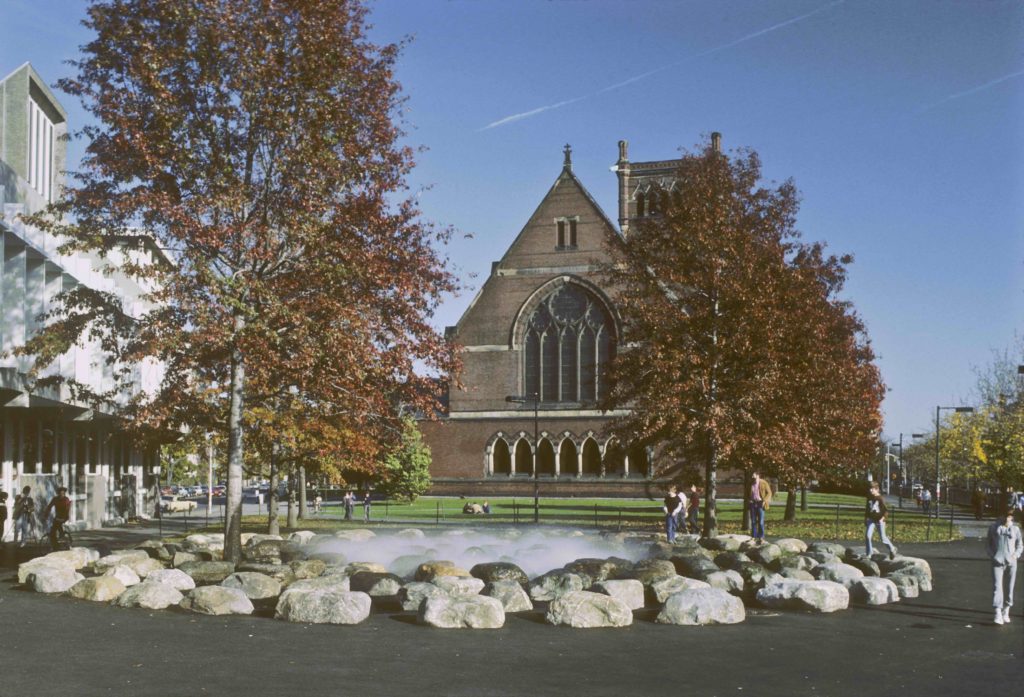
Architect
PWP Landscape Architecture
Type of Area
Ornamental water feature or fountain
Land/water interaction
Fountain
Built Environment Types
Completely built
Scale of Impact
Place
Block
Intervention Scale (Spatial)
Single object
Project Types
Urban water features
Outdoor Recreation
Urban design
Urban/ Rural
Inner urban area
Visibility and Openness
Fully enclosed
Fully contained view
A Meeting Place.
The innovative Tanner Fountain is situated on the Harvard University campus. This small-scale intervention was created as part of the “Landscape as Art” movement, originating from the Harvard’s Graduate School of Design Landscape Architecture Expression Studio.
The fountain without a basin was intended to solve the problem of maintenance crews converting high maintenance fountains into planters. The creation of a minimalist fountain has had a large effect on a busy pedestrian crossroad between Harvard Yard, the Science Centre and Memorial Hall.
The fountain is intended as a place where the public can meet, play, explore and relax in an evocative and poetic atmosphere. The 159 boulders are arranged in an 18m diameter of irregular concentric circles surrounding two existing trees. A shimmering mist is created by a ring of 32 jets flush to the ground, 6 m in diameter, that playfully conceals the centre of the installation and gives it a sense of life.
In spring, summer and autumn the mist hovers over the stones but in winter it is empty and the stones are covered in snow. Additionally, the fountain provides a cooling effect in summer. At night the fountain is lit giving it a mysterious glow, thus the space provides a temporal and seasonal contemplative landscape.
The stones for the project were sourced from cleared New England fields and were partially buried in the ground, smooth side up. Grass, asphalt and concrete paths run through the installation providing access. Whilst the place is designed as a meeting place, the stones are strategically placed to prevent passageways for skateboarders and rollerbladers.
.
Perception and Meaning
Focal point
Imageability
Place identity
Knowledgeability
Sense of ownership
Health and Wellbeing
Restorativeness
Aesthetic experience
Place affordance
Attention
Interaction with Water
Visual
Tactile – Partly in water

Website of the project:
http://www.pwpla.com/projects/tanner-fountain-harvard-university
Google map reference
The ratings show the site is accessible by foot and by bicycle, but car access is restricted, which is understandable for a campus site. The design quality generally is good, but site circulation is deliberately reduced to prevent misuse of the fountain area and to maintain the site as a place to relax. As mentioned, fountains often require high maintenance input and therefore it scores lower for this.
The range of facilities of this small-scale intervention is low, but these will be provided close by on this campus site. The stones and nearby lawns are the only seating areas provided and the quality of nature is low due to its position in a busy pedestrianised area, although trees do provide shade but not protection from the wind.
Health and wellbeing is generally rated as good as the fountain provides a place to relax and meet with others in an informal setting. Again, due to its proximity to a busy campus pedestrianised area the sense of being away is necessarily limited.
Generally access to the water is good as it is possible to walk through the fountain area, but rated low for water safety features and access from the water as they are not needed or possible. As a small-scale fountain intervention the range of physical activities is also low and it is designed as a place to relax, not for sport, and therefore its low rating in this aspect is not part of the project brief.
